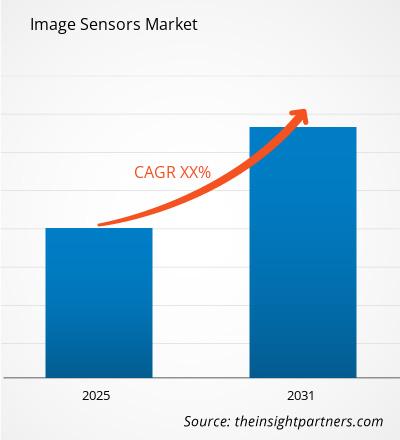페이지 업데이트됨 :
May 2018
디지털 카메라나 카메라 모듈과 같은 다양한 이미징 장치는 렌즈를 통해 전기 신호 형태로 광학 이미지를 얻는 기술을 사용합니다. 이 기능은 이미징 센서라고 하는 센서에 의해 수행됩니다. 이미징 센서가 더 나은 화질을 제공할 것이라는 기대를 받으면서 이 기술은 시간이 지남에 따라 기존 카메라를 따라잡았습니다. 디지털 카메라는 기술적으로 빛의 굴절과 일련의 포토사이트를 사용하여 이미지를 포착합니다. 카메라에서 이미지를 생성하는 데 사용되는 빛은 이미지 센서의 종류에 따라 다르며, 이미지 품질 또한 센서의 종류에 따라 달라집니다. 센서가 클수록 화질이 좋으며, 그 반대의 경우도 마찬가지입니다. 대형 센서는 주로 디지털 카메라나 전문가용 카메라에 사용되고, 소형 센서는 모바일이나 태블릿 일체형 카메라에 사용됩니다. 또한, 디지털 일안 반사식(DSLR)에는 대형 센서가 내장된 교환식 렌즈가 장착되어 있습니다. 오늘날 셀카 세대의 더 나은 화질에 대한 요구가 증가함에 따라 태블릿, 휴대폰, 컴퓨터, 디지털 카메라와 같은 카메라 일체형 기기에 대한 수요가 급증하고 있으며, 이는 이미지 센서 시장의 주요 성장 동력으로 여겨집니다. 또한, 백라이트 조명, CMOS(Complementary Metal-Oxide Semiconductor)와 같은 센서 기술의 발전과 이미지 센서의 저렴한 가용성과 같은 다른 요인들이 전 세계적으로 시장을 활성화할 것으로 예상됩니다. 시장을 방해하는 주요 이유는 정지 이미지 촬영을 위해 특별히 설계된 사진 장비에 대한 수요 감소와 이러한 장치의 높은 유지 보수 비용일 수 있습니다. 이미지 센싱 시장은 보안, 의료 및 건축 산업과 같은 수직 시장에서 성장 가능성이 큽니다. 이러한 산업에서 고급 이미지 기술에 대한 수요가 날로 증가함에 따라 이미지 센서 시장에 큰 기회가 창출됩니다. 이 시장은 기술, 응용 분야 및 지역을 기준으로 세분화됩니다. 이미지 센서 시장의 기술 부문은 전하 결합 소자(CCD), CMOS, 접촉 이미지 센서(CIS) 및 하이브리드로 구성됩니다. CMOS는 다른 기술보다 비용 효율적이고 전력 소모가 적으며 대부분의 전자 장치 제조업체에서도 사용되므로 다른 기술과 관련하여 시장에서 지배력을 가지고 있습니다. 이미지 센서 시장의 응용 분야는 자동차, 가전 제품, 항공 우주, 방위, 의료 및 감시 산업으로 분류됩니다. 응용 분야 관점에서는 가전제품이 시장 점유율의 대부분을 차지하며, 의료 및 감시 분야가 그 뒤를 따릅니다. 시장은 북미, 아시아 태평양, 유럽, 남미, 중동 및 아프리카의 5개 지역으로 크게 세분화됩니다. 지역별 시장 세분화는 아시아 태평양 지역, 특히 중국, 일본, 한국이 전체 시장의 4분의 1 이상을 차지하며, 그 뒤를 북미와 유럽이 잇고 있습니다. 북미와 유럽은 꾸준한 성장세를 보이며 향후 몇 년 안에 시장 점유율을 확대할 것으로 예상됩니다. 남미와 중동 등 다른 지역도 예측 기간 동안 적절한 성장률을 기록할 것으로 예상됩니다. 이 시장의 주요 기업으로는 GalaxyCore Inc., SK Hynix Inc., Samsung Electronics Co. Ltd., Toshiba Corporation, Panasonic Corporation, ON Semiconductor Corporation, Sony Corporation, Sharp Corporation, Omni Vision technologies Inc., Teledyne Technologies, Inc., CMOSIS NV, e2v technologies Inc., Baumer, Ltd., Honeywell Process Solutions, Weber Ultrasonics GmbH, Nanomotion, Ltd., Siemens AG, Pepperel+Fuchs GmbH 등이 있습니다.


요구 사항에 맞게 이 보고서를 사용자 정의하십시오.
이 보고서의 일부, 국가 수준 분석, Excel 데이터 팩을 포함하여 모든 보고서에 대한 사용자 정의를 무료로 받을 수 있을 뿐만 아니라 스타트업 및 대학을 위한 훌륭한 제안 및 할인을 이용할 수 있습니다
이미지 센서 시장: 전략적 통찰력

- 이 보고서의 주요 주요 시장 동향을 확인하세요.이 무료 샘플에는 시장 동향부터 추정 및 예측에 이르기까지 데이터 분석이 포함됩니다.
이미지 센서 시장 지역별 통찰력
The Insight Partners의 분석가들은 예측 기간 동안 이미지 센서 시장에 영향을 미치는 지역별 동향과 요인들을 면밀히 분석했습니다. 이 섹션에서는 북미, 유럽, 아시아 태평양, 중동 및 아프리카, 그리고 중남미 지역의 이미지 센서 시장 부문 및 지역별 현황도 다룹니다.
이미지 센서 시장 보고서 범위
| 보고서 속성 | 세부 |
|---|---|
| 시장 규모 2024 | US$ XX million |
| 시장규모별 2031 | US$ XX Million |
| 글로벌 CAGR (2025 - 2031) | XX% |
| 이전 데이터 | 2021-2023 |
| 예측 기간 | 2025-2031 |
| 다루는 세그먼트 |
By 유형 |
| 포함된 지역 및 국가 | 북미
|
| 시장 선도 기업 및 주요 회사 프로필 |
|
이미지 센서 시장 참여자 밀도: 비즈니스 역학에 미치는 영향 이해
이미지 센서 시장은 소비자 선호도 변화, 기술 발전, 그리고 제품 이점에 대한 인식 제고 등의 요인으로 인한 최종 사용자 수요 증가에 힘입어 빠르게 성장하고 있습니다. 수요가 증가함에 따라 기업들은 제품 라인업을 확장하고, 소비자 니즈를 충족하기 위한 혁신을 추진하며, 새로운 트렌드를 적극 활용하고 있으며, 이는 시장 성장을 더욱 가속화하고 있습니다.

- 을 얻으세요 이미지 센서 시장 주요 주요 플레이어 개요
- 과거 분석(2년), 기준 연도, CAGR을 포함한 예측(7년)
- PEST 및 SWOT 분석
- 시장 규모 가치/거래량 - 글로벌, 지역, 국가
- 산업 및 경쟁 환경
- Excel 데이터세트
최근 보고서
관련 보고서
사용 후기
구매 이유
- 정보에 기반한 의사 결정
- 시장 역학 이해
- 경쟁 분석
- 고객 인사이트
- 시장 예측
- 위험 완화
- 전략 기획
- 투자 타당성 분석
- 신흥 시장 파악
- 마케팅 전략 강화
- 운영 효율성 향상
- 규제 동향에 발맞춰 대응
고객































87-673-9708

ISO 9001:2015





 무료 샘플 받기 - 이미지 센서 시장
무료 샘플 받기 - 이미지 센서 시장